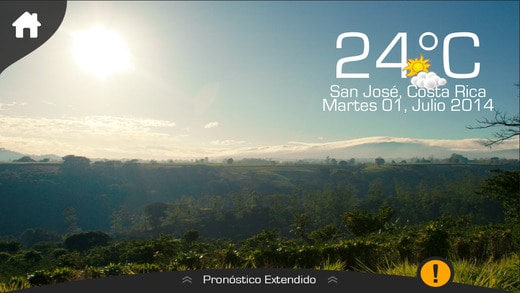
There are two opposing ways to look at Costa Rican weather. On the one hand, the weather here is very predictable. During the dry season, the skies will be sunny and azure all day. During the rainy season, the skies will be sunny in the morning, overcast at noon, and rainy by 3 p.m. Easy.
On the other hand, Costa Rican weather is a patchwork of microclimates, and if you’re a stickler for exact temperatures and hourly precipitation, the slightest shift in geography could drive you insane. Weather patterns on the country’s Caribbean coast are often completely different from those in the rest of the country, for example – but you don’t have to travel that far to find drastic differences. Lightning storms in Cartago may never reach Tres Ríos, a town only 14 kilometers away. Drivers in San José during a downpour often find that just a few blocks along, the streets and sidewalks are dry as a bone.
To help us prepare for the day, Costa Rica’s National Metereological Institute (IMN) recently released its own app. The app (simply called “IMN”) is available for iPhone and Android. (We tested it on an iPhone.) The program is a valiant effort to interpret the local troposphere for everyday people. Unfortunately, it has too many flaws and bugs to make it a worthy alternative to even the basic weather app that comes with an iPhone.
In short, the app is a total dud. You might as well use Weather Underground, as most web-savvy locals do, to estimate when to pack an umbrella. (Hint: always.) But the smartphone set may enjoy tinkering with the app, which is just quirky enough to keep you entertained throughout the day. You can use the handy map of Costa Rica to pinpoint your location (by province), although you might find yourself jabbing at the map with increasing ferocity as you try to specify your city. The app clearly hoped to appeal to tourists by offering an English-language option. However, the translation often is amusingly poor (ex. “partly cloudy” was written in Spanglish as “clouds parcial”).
What makes the app interesting is its globally minded extras, such as the “carbon footprint calculator,” which is an enjoyable diversion, if a little vague. (Do you enter your electric bill in dollars or colones? And when you enter it, why does the app suddenly crash? So many questions.) You can also play three different games: “Triviac” is a trivia game about the environment, and the more questions you answer correctly, the more your tree thrives. The questions aren’t easy, so if you’re not keen on Costa Rican climatology, the screen will read, “The tree grows withered.” Believe me, you do not want to see the withered tree, unless you love sadness. The touch-based games, such as “The Weather’s Administrator,” can be much more frustrating and are barely playable on your phone.
The nerdiest weather zealot will find pleasure in the final section, “Costa Rica’s Weather History,” which catalogues meteorological records for various locations, such as the precipitation in Turrialba for the past 12 months. Disappointingly, it’s almost impossible to read and navigate unless you have a fetish for charts with tiny fonts.
In summary, the IMN app is much like the forecasters on local TV: It’s hard to understand why they’re so enthusiastic about high pressure systems in the southeast, or what would compel them to stand in front of greens screens and pantomime before a superimposed digital map for a living, but they are also strangely compelling.
The IMN app has noble intentions: not only to predict atmospheric movement, but also to educate about the environment. But the crashes are too frequent and the overall product is too clunky. The app did send out an update Wednesday, but the changes didn’t demonstrate much of an improvement. It’s unfortunate that the IMN chose to launch — and promote! — the app when it is clearly not ready for prime time. Here’s hoping that updates keep coming quickly, and that Costa Rica and its peculiar weather patterns finally gets the app the country deserves.





